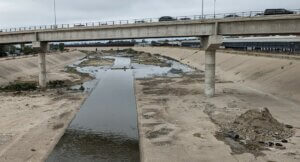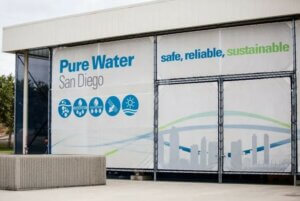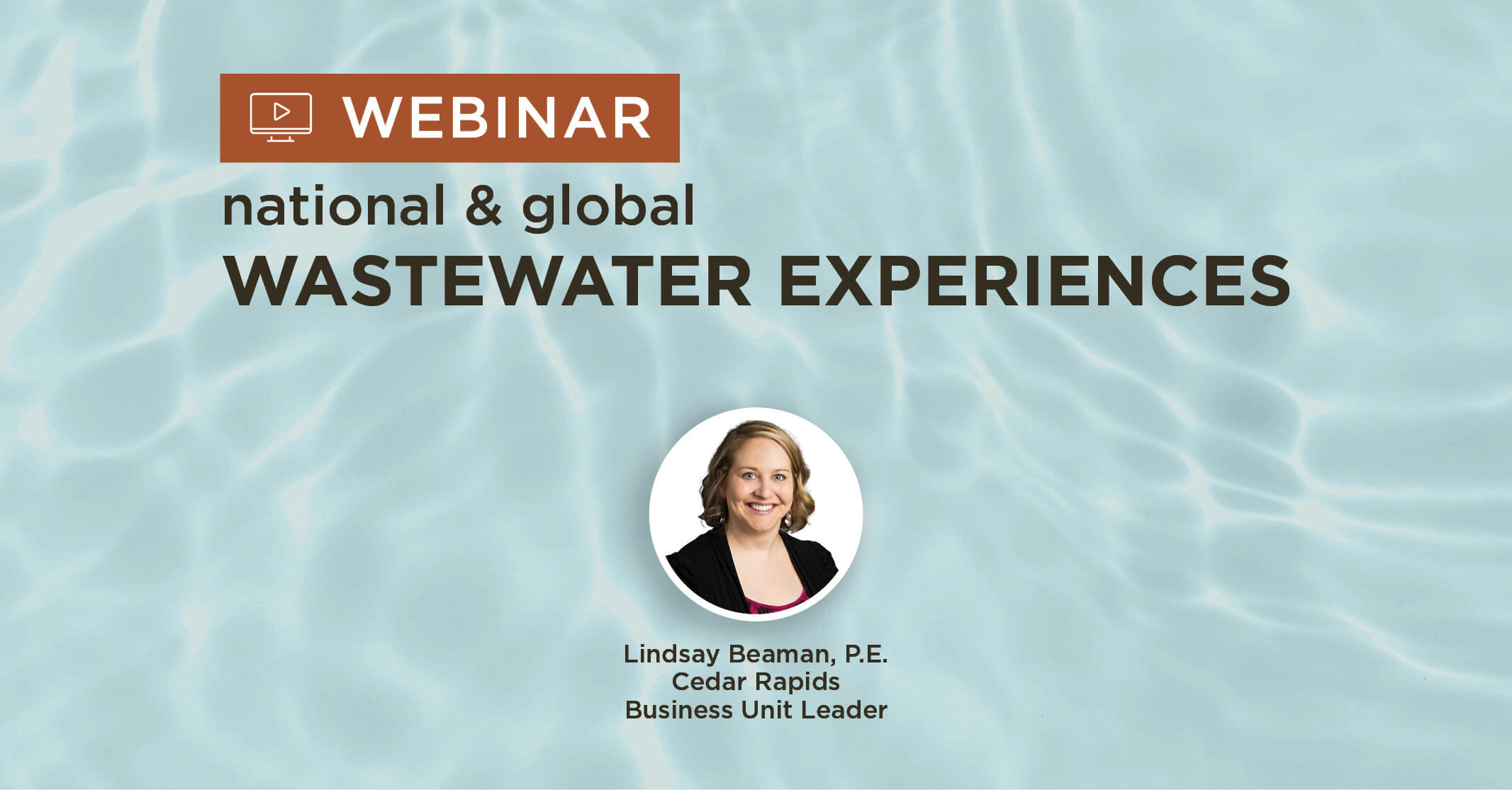Exploring the Wastewater Issues on the West Coast
The San Diego region faces a delicate balance between the growing demand for water and the imperative to preserve and enhance the quality of its water sources. As the population burgeons and climate change introduces new uncertainties, San Diego has grappled with issues such as water scarcity and contamination. The city has embarked on an innovative Pure Water San Diego initiative in response to these challenges. This ambitious project aims to secure a sustainable and resilient water supply by harnessing advanced purification technologies, thereby reducing reliance on imported water sources and mitigating the impact of droughts.
Listen as our wastewater engineer, Lindsay Beaman, P.E., discusses the intersection of water quality concerns and how the transformative goals of Pure Water San Diego encapsulate the city’s proactive approach to safeguarding its most precious resource.
Webinar Agenda
- National and Global Wastewater Experiences (00:14)
- PWX San Diego Conference (00:43)
- Water Quality Contamination – Flowing Across Borders (02:46)
- South Bay International Wastewater Treatment Plant (03:56)
- Pure Water San Diego (07:28)
- Five-Step Purification Process (11:02)
- Pure Water Program Funding (12:51)
- Point Loma Wastewater Treatment Plant (14:20)

Lindsay Beaman, P.E.
Cedar Rapids Business Unit LeaderLindsay Beaman, P.E.
Cedar Rapids Business Unit LeaderWater System Analysis & Planning, Design & Construction, Wastewater Treatment Design, Municipal Engineering
National and Global Wastewater Experiences (00:14)
Okay, so I’m Lindsay Beaman. I went a different route with the presentation this year. I’m taking us out of the debate a little bit. I decided to do something a little more fun, so hopefully, you guys can play along.
Some disclaimers: I’m going to talk about some stuff that’s outside of Iowa. So, I am by no means an expert. I have no experience with it. I did some online research, I went to some presentations, so I got some information straight from the sources. But basically, I’m not the professional in these matters, so I apologize if I get anything incorrect.
PWX San Diego Conference (00:43)
This last September, I was given the opportunity as a consultant to go to the Public Works expo in San Diego, which is the American Public Works Association version of WEF Tech. So it’s a big old trade show.
The neat thing about these trade shows, when they’re out of the state, is you get an out-of-state perspective on the issues that’re important to the people that are presenting there. So, the water quality issues were very California-focused. So that’s what I have to share with you today. And while I’m there, like any good nerd does when they’re on vacation, you pay attention to the water wastewater problems where you’re vacationing because that’s what everybody does. And Coronado Beach happens to be just outside of San Diego, across the San Diego Bay. That’s a massive resort city. Real estate is expensive, with 2.2 million average median cost of a single-family home at 2.2 million as of this year. Tours are an essential part of their economy. They have major resorts. They’re the home of the US Naval Air Station, and that’s where BUDS and the SEALS prep schools are held. Here’s a picture of the beach. I promise you I’m not just going to do vacation photos, but there’s something critical wrong at this beach. Nobody’s allowed to swim because of E. coli contamination in the ocean. Like you think we have problems with our lakes. Their ocean is so contaminated that there is no swimming allowed in the beach, and this is in a very expensive resort community. As of Labor Day weekend this year, while I was there, 12 miles of beaches along California were closed to any sort of water access. Some brave souls do get in the water.
Here is just a metric. If you can see, it’s showing beach closures. This was through May of 2023, and the bars on the far right are 2023. That is basically half the year. So, by the middle of 2023 already, the beaches have been closed for half the year. So I mean, this is a major impact to their economy and I can imagine since where we are today, you can guess where I’m going with where this problem is coming from. They have websites solely dedicated to beach watch. You could click on your beach, find out what your contamination level is, if it’s red, yellow, or green, and if you should be going to the beach that day or not.
Water Quality Contamination – Flowing Across Borders (02:46)
So why are these beaches polluted with E. coli? Because as much as you can control a lot of things in the border, you cannot control the direction of water flow. The entire city of Tijuana is located just south of San Diego and while a lot of their wastewater is collected and distributed elsewhere, quite a bit ends up in the Tijuana River, which flows north as the river flows north, it outlets into the Pacific Ocean. Gulf Streams are the warm ocean currents bring water north, and that’s how that wastewater ends up polluting San Diego, which is not that far from the border. Basically, major bypasses are ending up in that river all the time.

Much of Tijuana’s wastewater is pumped directly to the Pacific Ocean, but major bypasses end up in the Tijuana River when this infrastructure breaks.
Here’s a picture of the Tijuana River through Tijuana. If you can see for scale, there’s a man standing in the middle of that water collecting stuff at the dam he’s created. I’m not sure what he’s collecting. Some treasures. So this scale is very hard to see, but this is a huge channel, and it was nasty. It was really nasty. So basically, yeah, this is the Tijuana wastewater flow. This is probably hard to see, but a lot of other wastewater is collected and treated or sent elsewhere, you know, south of the border. But also, a lot of it is collected and sent north of the border.
South Bay International Wastewater Treatment Plant (03:56)
There is, and this was fascinating to me; among this one, there’s three wastewater treatment plants that the US owns and operates that are actually international treatment plants. One of which is the South Bay International Wastewater Treatment Plant. This one is located just north of that border. This was authorized by Congress and agreed by both countries to build around 1990. Completed in 97, its sole purpose was to mitigate pollution coming from the city of Tijuana, including the Tijuana River. USEPA paid for the majority of the plant. Clearly, our interests aligned in trying to help clean up this problem. The investment was due to the fact that because of its impact to San Diego and the sewage flow was causing closure for beaches and, you know, putting people at risk that municipalized governments for both countries wanted to see something fixed. So, the initial cost in the nineties was 239 million, and they ended up adding secondary treatment later for an additional 18 million. And so this plant was designed then and still currently treats 25 MGD and discharges through a four-and-a-half mile, 11-foot pipe to the Pacific Ocean.
So, this plant was created to help with the Tijuana pollution coming from their wastewater collection system. Again, completed in the nineties, it consists of some mechanical bar screens, grit removal, primary clarification, they have activated sludge, secondary clarification, deep bed mono media filtration, EDR, and UV disinfection. So basic, you know what we’re used to. The wastewater plant is doing its job. It’s designed to do what we expect of a wastewater plant. Their soils are pumped further north to a different wastewater plant in San Diego for processing.
In addition to, you know, just the regular domestic wastewater, they do have their own SIUs they contend with. Anywhere from meat, food manufacturing, metals processing, and commercial laundry. They have pretreatment programs. They deal with a lot of struggles with the infrastructure. I don’t know if you could read the title on that headline, but it was pipe blows again in Tiajuana, sewage spills into San Diego. So anytime the infrastructure fails, the water is being bypassed to the river. That’s a pretty big hole in that pipe.
So because obviously, it’s still today in this last year, they’re still having issues, they’ve been having issues. In 2020, the US and Mexico allocated money to double the capacities. The problems were that Tijuana has exploded in growth. The capacity doesn’t keep up with what it could be used for. The Baja region has grown by more than a million since that plant was built. They wanted to push more untreated wastewater to this plant, and so they came up with a price tag for that. In 2022, from my understanding is they got an engineering firm involved to do some preliminary design recommendation costs, as you know, the whole phasing of what do we do next. And out of that, they found out that they need like over 150 million just to get the plant in shape for what it’s doing now. There’s no upgrade happening until 150 million and deferred maintenance is addressed. So that’s got everybody really hot out there. So if you are in San Diego, you can read a lot of really good news stories about how everyone’s infighting about these issues, and there’s not a lot of good solutions because, obviously, people don’t want to invest in someone else’s problem. But there you have it. I don’t know what else you do. So it’s a really interesting story. I don’t have an aha moment yet because that’s all I know so far.
So, Tijuana’s faulty system is causing the problems. Their residents also suffer these impacts. I mean, honestly, they’re not just dumping it on us. They probably have zero to almost nothing for treatment anywhere in their communities. Their ocean beaches are polluted as well. So yeah, like I said, it was fascinating to learn we have three international plants across the border. So that’s something just interesting I never knew.
Pure Water San Diego (07:28)

Pure Water San Diego aims to use water purification technology to clean recycled water to produce safe, high-quality drinking water.
So, while I was at this conference, another big point of the conference was called Pure Water San Diego. I don’t know if you guys pay attention to some of the drinking water crises. A lot is in the news about the Colorado River and its fight for who gets the water from the Colorado River in![]() the southwest US.
the southwest US.
San Diego imports 85% of its water supply, and most of that’s coming from the Colorado River. In the last 15 years, the cost to import that water from the river has tripled. And so, they have come up with a goal to reach half of their water supply locally by 2035. And this is the total need on behalf of the city. In 2004, the city, foreseeing this coming, started a massive plan to look at options for what this reliability of drinking water could look like. Do you see where I’m going with this one as well? Because this is a wastewater conference.
Recycling Wastewater
Currently, 8% of wastewater in San Diego is recycled, but since 2011, they’ve been able to produce one MGD of recycled wastewater at a pilot site. That’s over a decade that they’ve been concepting this idea. They have taken 50,000 tests that have passed drinking water standards in that time. I don’t know if many failed. They don’t put that put that on their website. But 50,000 tests. They are very proud. They have spent a lot of time, and have had a lot of really good success out of recycling wastewater and turning it into drinking water.
So, just a little bit. I mean I found fascinating the scope of some of their projects and what they’re doing in order to combat this issue. I mean I went to a presentation from the people that are in charge of these programs. So it’s pretty impressive to listen to, you know, how different their problems are compared to ours and how they have to come about it a completely different way. But they have ten projects in process right now that are going to be able to produce 30 million gallons per day by 2025. So that’s not that far from now, guys.
Phase 1 of the Pure Water Program
Part of that is the reclamation plant. They need to get more wastewater to the plant, and they’re going to upgrade and expand that. They’re going to be building pump stations, pipelines, tunnels. They have major interstate infrastructure that you don’t just close for moments to bore through. Of these projects, we’re talking a 32 MGD purification plant with two 10-and-a-half mile pipelines. One is 48-inch wastewater to pipe wastewater north and another 30-inch to pipe brine wastewater back south to the plant. The facility is going to, like I said, produce 30 MGD through a five-step purification process, which I’ll get into in a moment. But I do like in this photo I found, and these are photos from the actual project. They don’t look like they go as deep as we do. So that looks a little bit easier to construct. That does not look like it’s more than a couple of feet buried. So that is one benefit of some of these force mains.
They’re upgrading the reclamation plant like I said, because they were already doing some purification of wastewater to remove some contaminants. They have flow equalization basin needs like I said, pipelines and tunnels, and they need bio-cell improvements because they’re obviously going to have a lot more bio salts coming to their process.
Another process than after purified, which I’ll get into the pro-purification process, but after it’s purified, it doesn’t go to the distribution system. It’s getting pumped into the reservoir. My guess is a lot of that has to do with the ick factor. Just blending it back in sounds a lot cleaner. So yeah, we’ve got a 30 MGD pump station that’s going to take the purified water 8.4 miles to the reservoir. They’re going to de-chlorinate it on the way there and then they’re dropping, and already have done this, a one-mile pipeline into the bottom of the lake for distribution.
Phase 2 Pure Water Program
So, phase two, which there is not much about, is another 53 MGD of all of this by 2035, so in the next ten years.
Five-Step Purification Process (11:02)
The five-step purification process starts with ozonation. Ozonation is what you produce: ozone gas. You subject the oxygen molecules to high voltages, you infuse that into the water, where ozone is able to destroy microorganisms and break down contaminants. Then, the ozone itself breaks down in oxygen. So step one, ozonation.
Step two is biological activated carbon filters. You’re going to have granulars covered with bacteria. Imagine less filter, more like a trickling filter, so more of a capture of the bacteria and treating it with anaerobes, consuming another 30 to 50% of the organic matter.
Step three is membrane filtration. So canisters of membrane fibers. This is assumed to remove 99.99% of microscopic particles. The pores in these fibers are smaller than one 300 diameter of human hair. So we’re at step three, we’re really getting down there in the size of the treatment process.
RO is next. Step number four is reverse osmosis, which uses high pressure to force water through membranes. Another 99% of dissolved organics, including pharmaceuticals and personal care products, are removed in this step.
Then, UV disinfection. So now we’re going to use the 72 UV bulbs to break down further viruses and microbes and advanced oxidation generators to oxidize any final trace contaminants.
So, five steps and then dump into the reservoir. I’m assuming this water is probably getting pretty much cleaner than the reservoir by this point, but there you have it. That’s the water that has met their 50,000 federal drinking water requirements, and they are now well on their way to making 30 MGDF to start drinking by 2025.
Pure Water Program Funding (12:51)
The first phase, phase one, I talked about, which is all a lot of the piping, the tunneling, the upsizing, the plant itself, 1.5 billion for planning, design and construction. So that’s what they’re spending essentially between three or four years. They literally say TBD on phase two. They don’t know phase two costs yet.
From my research, it looked like they did get some federal help in this, but they’re taking out some massive SRF loans as well. So there’s a lot of loan financing that’s happening for these projects. Now, it’s so expensive they can afford it? Yes, I heard that. They can’t afford to not do it. So, I did some conversions here. So the costs of importing water, like I think I said, tripled from 2000 to 2023 and it’s expected to double in the next ten years. So, I did some conversions to make this comparable to Waterloo, Iowa. Online, Waterloo, Iowa, says they make 1.4 MGD water a day on average. I compared that to the acre to feet that they’re converting that. So if Waterloo, Iowa is looking at these prices, that’s $14,000 per day for producing water in 2000. That’s $52,000 in 2023. That is $105,000 a day in 2034. That is the prices they’re looking at. They can’t afford not to do this with the import of water and what it requires for them just to serve their communities. They cannot afford to not do it.
Piloting has demonstrated effectiveness. Construction is well underway. There’s no going back. So the next time you go to San Diego, remember that when you drink the water.
Point Loma Wastewater Treatment Plant (14:20)
I have one more story out of San Diego. You start digging. You start finding more fun things. Their big wastewater treatment plant is called the Point Loma wastewater treatment plant. And the more I dug into Pure Water, the more I found out about Point Loma because they’re able to offset upgrading treatment plant needs because of what they’re doing on the drinking water side. So, they’re using that to kind of bargain with the Fed.
So, this treatment plant, if you can see San Diego, it’s out there. I mean that whole long stretch of, if you can see that along the bay, that was the beach that’s closed. So now you got a wastewater treatment plant north of the entire beach that’s discharging the ocean. That is a San Diego treatment plant.
It’s been open since the sixties. It treats about 175 MGD, it’s got to double that capacity, and serves 2.2 million residents. It’s considered advanced primary treatment.
Advanced primary treatment. These are the keys. They call it a chemically enhanced primary treatment facility. Because all it has is screening and grit removal, chemical addition, and a sedimentation tank, that is all it does. That is it after the sedimentation. A lot of odor scrubbers because of where it is in the city, and that is it. They discharge it in what they call probably the longest and deepest effluent pipe in the state and in the US. It’s 4.5 miles off the coast, 310 feet deep. So they essentially drop it out long and far away. And the analysis is that because of the temperature variations in the waters, a lot of the solids just stay down there. They have nowhere to go. I mean, it’s still cold that it just traps everything down deep. So, the wastewater really doesn’t have much of an impact.
They do anaerobic digestion for solid reduction in methane production. They pump their sludge 17.5 miles to a centrifuge. The international wastewater plant pumps their sludge to this same sludge processing, and the sludge generated by the purification center will all essentially go to the same place. So all the solids handled, I mean, I can’t even fathom that the miles of sludge pumping across a city. It just boggles my mind how much maintenance there is in those lines.
They have what is called an alternate discharge standard because scientific studies have indicated, this is quoted directly out of the EPA, “in open coastal waters and well flush estuaries oxygen depletion due to BOD from wastewater discharges is generally of no ecological concern.” So because of where it’s going and how it’s going there, it does not indicate any harm. They’re only meeting 80% removal of TSS and 58% BOD. Isn’t that insane? After what we just talked about with what they’re doing with their drinking water, this is what they’re doing with their wastewater.
So that was why it just blew my mind. But you know, this goes to show that the EPA totes a lot of their integrated planning. You know, you’ve got to do many things. Let’s talk about a plan to do the right things first or not break yourself trying to fix problem B when problem A is more important, etc. This is exactly what they’re doing because they’re doing this pure water system and they’re essentially going to be capturing more and more of their wastewater. Why fix the wastewater? So, they have a plan in place with EPA that says you’re not hurting anything in theory, you’re drinking more of your wastewater, so you’re going to be taking it out in the next ten years anyway, we’re diverting 1.8 billion in theoretical wastewater treatment expenditures to drinking water. So essentially, they are saving money there for their drinking water as well. It’s estimated about 1.8 billion would be needed to upgrade this plant to meet current standards. So, they’re allowed to continue to have that 80% TSS removal rate and 58% BOD removal rate. And that’s how they operate. It just like I said, baffling, it’s just a primary treatment plant.
So yeah, like I said, enter Pure Water San Diego to save the day. As Pure Water is diverting more San Diego wastewater into the water supply, this will reduce the ocean discharges. Their modified permit basically says, you know, even as you divert this away, your loadings are always going to be decreasing. So, it doesn’t matter if as the city grows, your loadings are decreasing. There’s really nothing, you’re not contributing any more wastewater to the ocean so you’re loading is down. So, you’re allowed to keep doing this and producing 83 MGD of potable reused water by 2035. So it’s allowed.
So that was all I had. Thank you everyone.

